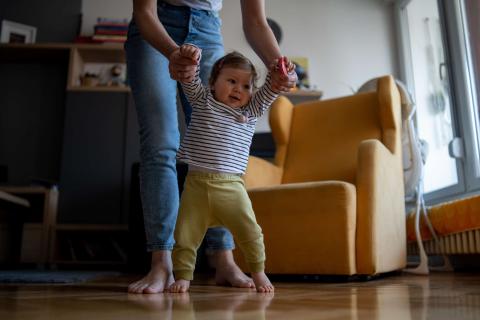It’s exciting when your baby starts to move on their own. And the first big step is when they start to roll. Most babies start to roll at around 6 months old. Some very energetic wee ones even start to roll as early as 3 to 4 months, so watch out!
Things to remember
It’s important to remember that all babies develop at different speeds and you shouldn’t be overly concerned if your wee one is going at their own pace. This is especially true if your baby is born premature.
If your baby is under 8 weeks old, you can find out more about their milestones at Ready Steady Baby.
Learning new physical skills isn’t easy for babies and can sometimes cause them to get upset and cry. This can be hard for you too, so remember to ask family and friends for support, or speak to your Health Visitor or Family Nurse for advice.
Fun ways to get the ball (and your baby) rolling
There are lots of simple things you can do to encourage your baby to get roll ready. Try out some of our tips below – and they’ll soon be ready to rock and roll!
You can find more tips for encouraging your wee one to roll over in this video from NHSGGC.
Tip #1: Floor time

Giving your baby lots of floor time on their back allows them to move their arms and legs. Placing toys at their side or lying alongside them on the floor will also encourage them to turn to their side. A baby gym helps baby to stay on their back for longer, especially if the items above them rattle or move when touched.
Tip #2: Side ways

From 4 months old, playing while lying on their side helps your baby get used to being in this position. At the start you might need to help support them by holding your hand on their back. Putting toys in front of them will also keep them interested and entertained. You can also lie alongside them, face to face, singing and enjoy some time together.
Tip #3: Tummy time

Tummy time helps strengthen your baby’s neck muscles. This helps for rolling, sitting up and eventually crawling and walking. Placing some of their favourite toys where they can see them will also encourage them to lift their head. Find out more about tummy time and try these ideas to make it more fun and challenging.
Staying safe
Once your baby starts to move around on their own, it’s important to keep a close eye on them. Make sure the space around them is safe to explore and your home is baby proofed.
You should also never leave your baby unsupervised on any kind of raised surface, such as a bed, sofa or changing mat. Even if they haven’t started rolling yet, they have to start sometime and could surprise you.
When it comes to safe sleeping, once your baby can move from their back to their front and back again by themselves, they’ll be able to find their own sleeping position. The first few times they roll onto their tummy, you can gently turn them back, but don’t feel you have to get up all night to check.
You can also give them some tummy time while they are awake to help their development. Make sure you don’t leave them whenever they’re on their front.
Should I be worried?
If your baby isn’t rolling by 6 months, it’s a good time to ask your Health Visitor or Family Nurse for advice. Or if you have any other concerns at any stage of your baby’s development, you can also discuss this with your Health Visitor or Family Nurse. If your baby is premature and receiving follow up care, you can also get advice from your developmental team.
If you have twins, triplets or more they may take a bit longer to reach milestones, especially if they were born prematurely. It’s best to talk to your health visitor if you have any concerns. You can find out more about milestones for multiples on the Twins Trust website.
Learning new physical skills can be hard for babies and it’s normal for them to cry. If they get really frustrated, they can cry in an angry way and their faces can turn quite red. You might find this worrying, but as long as your baby is not having breathing difficulties, there is nothing to be alarmed about. Just try to comfort and settle your baby as normal.
 Activities & Play
Activities & Play Behaviour
Behaviour Childcare
Childcare Development & Growing Up
Development & Growing Up Family, Friends & Relationships
Family, Friends & Relationships Feeding Your Baby
Feeding Your Baby Food & Eating
Food & Eating Health & Safety
Health & Safety Mental Health & Wellbeing
Mental Health & Wellbeing Money & Work
Money & Work Online Behaviour & Safety
Online Behaviour & Safety Pregnancy & First Days
Pregnancy & First Days School & Education
School & Education Sleep
Sleep











 Family, Friends & Relationships
Family, Friends & Relationships
 Mental Health & Wellbeing
Mental Health & Wellbeing